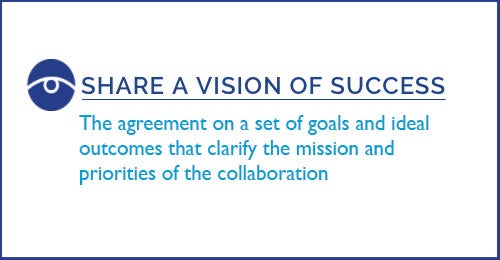Nov 15 2016 Diving Into The Intersector Toolkit: Share a Vision of Success
 We recently updated our Toolkit for Intersector Collaboration to provide even more useful advice to practitioners involved in cross-sector collaborations. Each week we’ll be profiling one of our 17 tools, with a focus on resources that can help collaborations succeed.
We recently updated our Toolkit for Intersector Collaboration to provide even more useful advice to practitioners involved in cross-sector collaborations. Each week we’ll be profiling one of our 17 tools, with a focus on resources that can help collaborations succeed.
Last week, we shared some helpful tips and resources related to Engaging Potential Partners in a cross-sector collaboration. Once partners have agreed to work together, they must turn to Sharing a Vision of Success — the second tool in The Intersector Project Toolkit — which entails some of the first collective decision making in a collaboration’s journey. Reaching agreement on a set of goals and ideal outcomes that clarify the mission and priorities of the collaboration links stakeholders together and creates a mutual understanding of the benefits of success, setting the tone for the future of the collaboration.
Collaboration partners are likely to come to the collaboration with their own organization- and sector-specific priorities and mandates. The most effective collaborations acknowledge and welcome these differences: While they can complicate the process of agreeing on a shared vision, they go hand-in-hand with the complementary resources and capabilities that cross-sector partners bring to the partnership. As the collaboration works to develop its shared vision of success, partners should be encouraged to communicate their differing priorities openly and honestly, so that the collaboration can surface areas of shared agreement and mutual benefit, building a solid foundation for its work.
The Mapping the Collaborative Journey discussion in Evaluating Collaboratives: Reaching the Potential, a comprehensive resource for evaluating multi-stakeholder processes from the University of Wisconsin Cooperative Extension, walks collaboration partners through the process of creating a logic model, or “logically linked sequence of change,” that articulates a relationship between the collaboration’s work and the results and impact it hopes to achieve (found on pages 22-30). The authors of this tool point out that conversations to design a logic model often unearth “differences in perceptions and ideas about expected outcomes, procedures, and philosophies,” providing a platform to welcome and consider partners’ differing priorities and work toward consensus. Partners can use Mapping the Collaborative Journey to outline steps for turning partners’ contributions into outcomes of the collaboration and break down outcomes into a timeline of three categories — immediate, intermediate, and final.
The Objective Assessment, in the Partnership Development Toolkit, a guide from the European Commission for facilitators of EQUAL Development Partnerships (but easily adaptable to partners in a wide variety of issue areas), guides partners through an exercise to jointly identify desired outcomes related to a problem they wish to address (found in Section 2.2: Problem and Objective Assessment on pages 17-22). The assessment also guides partners through establishing a cause-to-effect hierarchy and a dot-voting process for prioritizing approaches to the shared vision of success. In the dot-voting process, participants are given a marker pen and are allowed to make a dot next to the options they wish to vote for. The option with the highest number of dots is the priority of participants. After illuminating the potentially disparate priorities of partners, further discussion can help reveal the criteria participants used to cast their vote and guide discussion to achieve consensus. This exercise calls for a facilitator.
Conversation for Generating Possibility and Conversation for Generating Opportunity in The Partnering Toolbook, a comprehensive guide to partnering across sectors from The Partnering Initiative, presents an imaginative brainstorming exercise encouraging all partners to envisage potential “breakthrough” outcomes for their collaboration and ultimately to agree on the collaboration’s shared commitment to pursuing a realistically achievable possibility (found on page 49). This exercise is designed to take from 30 minutes to just over an hour.
See Share a Vision of Success in our Toolkit for further discussion on this topic, questions to guide tool use, and more.
Explore the full Toolkit and each of the 17 tools with enhanced discussion, questions to guide tool use, and additional resources here.
